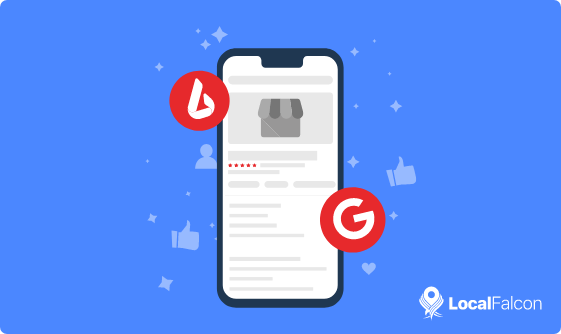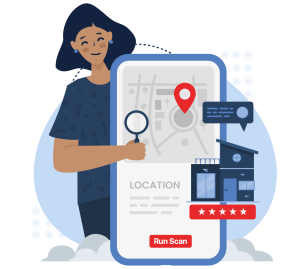When it comes to local SEO, businesses need to optimize their online presence wherever customers are searching.
Google Maps is the dominant player in the local search game, but Bing Maps still holds a small (and slowly growing) share of the market, meaning you shouldn't ignore it entirely.
Google Maps vs. Bing Maps: Local Search Showdown
Google Maps and Bing Maps are both mapping and navigation platforms with a heavy emphasis on helping people find, contact, and get to local businesses. While many of their features, like business listings, reviews, and pictures, are similar, there are some key differences in terms of their local SEO impact.
Market Share and Reach
With Google holding onto nearly 90% of the global search market share, Google Maps is the clear leader in local search. It has over a billion active users who rely on it for navigation, local business searches, and reviews.

Bing Maps, on the other hand, has a much smaller user base, with Bing's overall search market share hovering around 4%.
Because Google Maps is used by the vast majority of consumers, optimizing your Google Business Profile (GBP) should always be the top priority for local SEO.
However, Bing Maps still reaches around 100 million daily users, particularly people who use Microsoft products by default or have moved away from Google's ecosystem for one reason or another. So, maintaining accurate business information on Bing Maps (via Bing Places for Business) and optimizing for the platform can provide an additional visibility boost.
Managing User Reviews on Google Maps vs. Bing Maps
Google Maps pulls reviews directly from Google Business Profile listings. These Google reviews are a key ranking factor for local SEO, influencing a business's prominence in local search results in both the Google Maps app and in Google Search.
Bing Maps sources reviews from third-party platforms, including Tripadvisor, Yelp, Facebook, and others. This means that businesses with strong profiles and ratings on other platforms can appear prominently on Bing Maps, but there's no direct review system controlled by Bing itself.
Since Google reviews directly influence local rankings in Google Search and Maps, businesses should actively encourage satisfied customers to leave reviews on their profile. The more high-quality GBP reviews a business has, the more likely it is to appear in Google's local pack and rank higher in local search results.
Because Bing Maps doesn't have its own review system, businesses can't directly request or manage Bing reviews, but maintaining a strong reputation on other top local review platforms can potentially improve visibility on Bing.
Mobile Accessibility
One major limitation of Bing Maps is that it does not currently have a dedicated mobile app. While users can access Bing Maps through a mobile browser, the experience is not as seamless as using a native app.
Conversely, Google Maps has highly optimized mobile apps for both Android and iOS, making it the go-to navigation tool for many mobile users.
Mobile searches drive a significant portion of local business discovery, with "near me" and other types of searches with local intent skyrocketing in recent years.
Because Google Maps is the preferred navigation app for so many smartphone users, businesses that optimize for Google are far more likely to be found by potential customers searching for nearby products or services on mobile.
That being said, Bing's share of desktop users is higher than its overall market share, so optimizing for Bing Maps could potentially help you reach more desktop users. This could be beneficial depending on your target customers' search habits and preferences.
Managing Business Photos on Bing vs. Google Maps
Google Maps allows businesses and customers to upload photos directly to Google Business Profiles, making images a crucial part of a business's online presence on the platform. These photos are displayed prominently in search results and on Google Maps listings, helping potential customers get a visual sense of the business before visiting.
High-quality, regularly updated images on GBP listings can improve engagement and positively influence local search rankings. In fact, Google has recently been placing more emphasis on visual content and encouraging users to add more photos to their GBP listings, and local SEO experts predict their relevance will continue to increase.
Like Google, Bing also allows businesses or customers to upload photos to Bing Maps business listings. However, unlike Google, Bing mixes these images with photos pulled from third-party sources, like TripAdvisor, for example. This can make it more difficult for businesses to fully control which images appear most prominently on their listings, complicating visual optimization.
In order to maintain a strong visual presence on Bing Maps, businesses should not only upload photos directly, but also ensure their images on external platforms are high quality and up to date.

Bing Maps vs. Google Maps: Which Is Better for Local SEO?
There are plenty of other differences between Google Maps and Bing Maps that we could cover, but they're not as relevant to local SEO as the ones we've gone over above. Many of the other differences have to do with user interface and experience, such as search and navigation functionality.
After trying both Google and Bing Maps, it's safe to say that Google Maps is still the superior mapping platform, but what about when it comes to Local SEO?
Prioritize Google Maps, But Don't Ignore Bing
For businesses looking to attract more nearby customers through local SEO, Google Maps is the clear winner. It has a massive market share, its own review system that influences rankings, and a mobile-first approach.
However, Bing Maps is still worth some attention. While its market share is much smaller, it can potentially help businesses reach an additional 4% of users, especially those who default to using Bing through Microsoft devices and services.
Ultimately, a well-rounded local SEO strategy should prioritize Google Maps while still optimizing for Bing Maps for the additional visibility it can provide.


